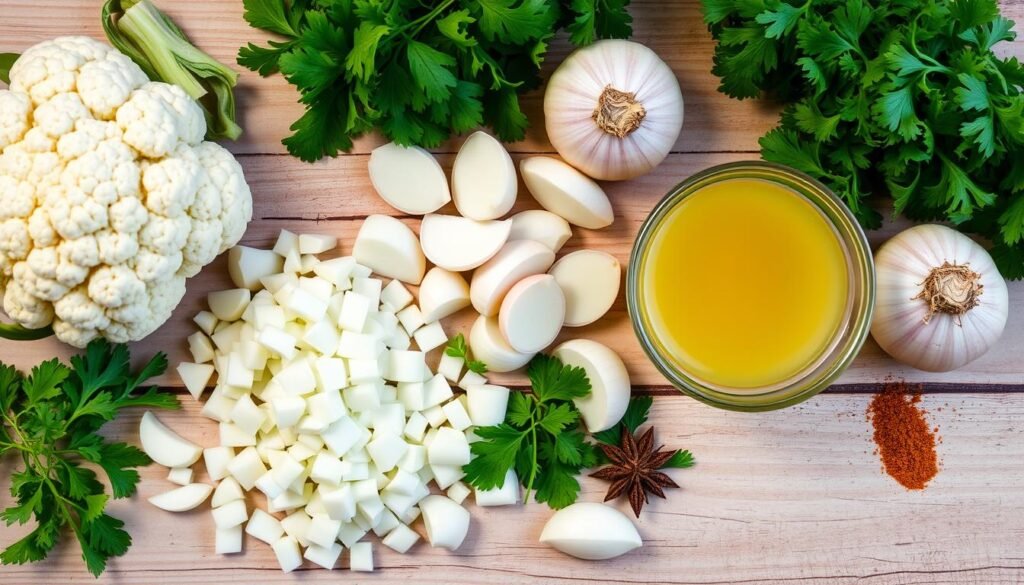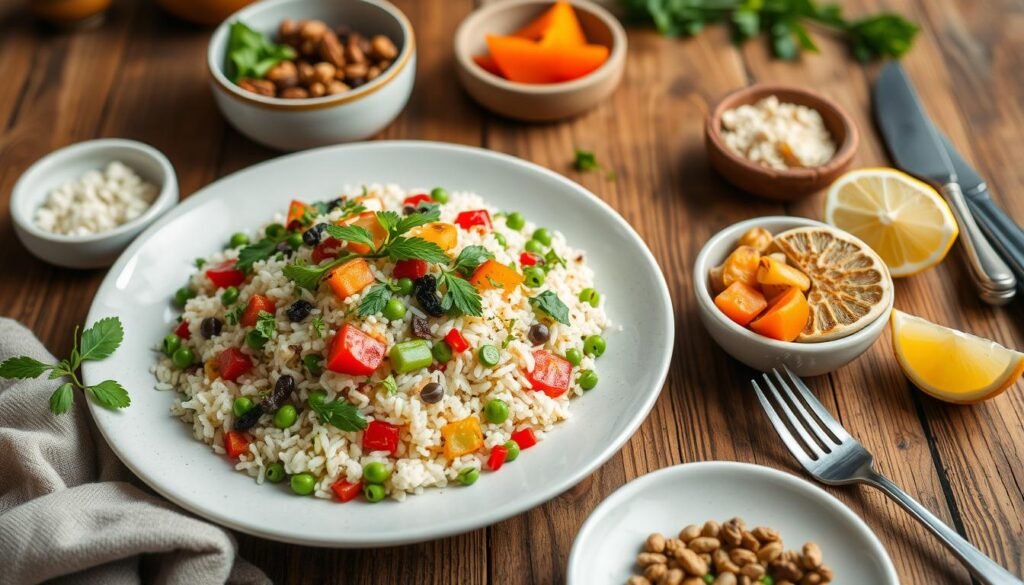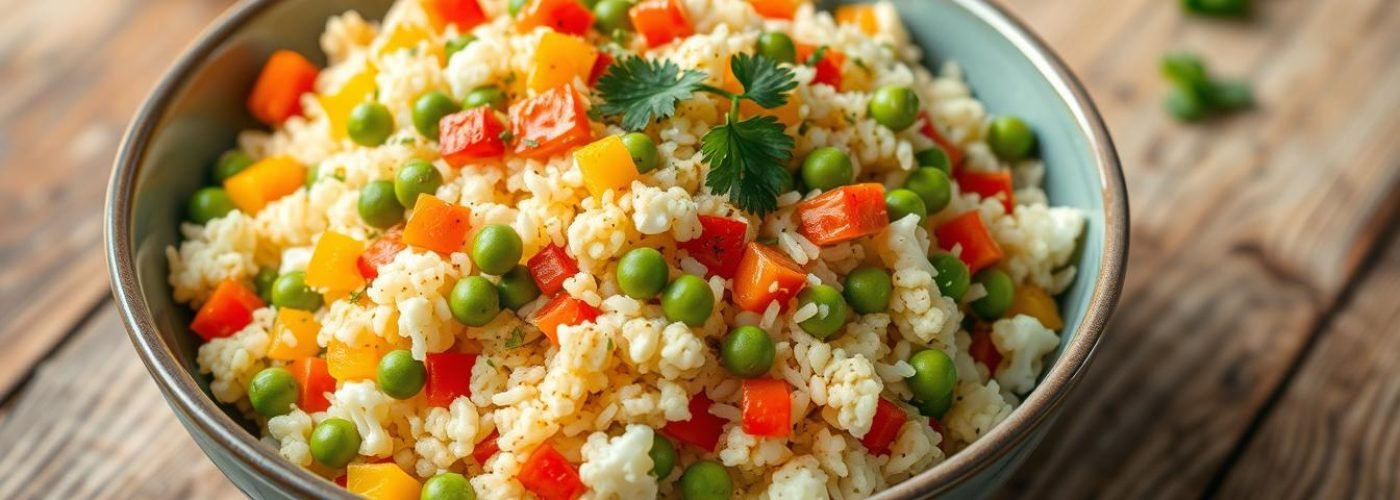Welcome to the world of Simple Cauliflower Rice Pilaf, a delightful dish that showcases the incredible versatility of cauliflower. This recipe is not only a celebration of fresh ingredients but also a fantastic option for anyone seeking healthy recipes or low-carb dishes. In this article, we will take you through everything you need to know about making this scrumptious pilaf, from understanding its benefits to providing detailed cooking instructions and serving suggestions.
What is Cauliflower Rice Pilaf?
Cauliflower Rice Pilaf serves as a flavorful and nutritious option compared to traditional rice pilaf. This dish involves finely chopping cauliflower into small pieces that mimic rice grains. Once prepared, it is sautéed with various vegetables, herbs, and spices that enhance its flavor profile. The essence of classic pilaf is retained while introducing significantly lower carbohydrates and higher nutritional value.
As a versatile base, cauliflower rice readily absorbs the flavors of accompanying ingredients, making it an excellent addition to numerous meals. With its unique texture and taste, cauliflower rice offers exciting culinary possibilities while supporting a healthier lifestyle.
Health Benefits of Cauliflower Rice
Cauliflower rice has gained popularity for its remarkable health benefits, making it a staple for those seeking to improve their diets. This versatile alternative to traditional rice not only offers a lower carbohydrate count but also packs a punch with vital nutrients. Let’s delve into its key advantages.
Low in Carbohydrates
One of the primary reasons cauliflower rice is embraced in low-carb diets is its significantly reduced carbohydrate content. A cup of cauliflower rice contains about 5 grams of carbs compared to approximately 45 grams found in a cup of cooked white rice. This makes it an excellent option for those managing their carbohydrate intake while enjoying a satisfying meal.
High in Nutrients
Cauliflower is not only low in carbs but is also a treasure trove of essential nutrients. It provides a rich supply of vitamins C, K, and B6 while offering fiber, antioxidants, and phytonutrients. These nutrient-dense foods contribute to improved immune function, enhanced bone health, and reduced inflammation, making them a healthful addition to any plate.
Great for Weight Management
Due to its low calorie and high fiber content, cauliflower rice can help people feel full for extended periods. This property promotes healthier eating habits, aligning perfectly with goals for weight management. Incorporating cauliflower rice into meals offers a delicious way to manage weight without sacrificing flavor.
Key Ingredients for Simple Cauliflower Rice Pilaf
Creating a delicious cauliflower rice pilaf requires thoughtful selection of key ingredients. Each component contributes to the flavor and overall experience of this healthy dish. Below are the essential cooking ingredients that make this pilaf recipe truly stand out.
Cauliflower
The star ingredient, cauliflower, serves as the base of this pilaf. Choose a fresh head of cauliflower or pre-riced cauliflower for convenience. Ricing the cauliflower creates a texture similar to traditional rice, making it an excellent substitute.
Vegetable Broth
Using vegetable broth instead of water infuses the dish with flavor and richness, enhancing the overall taste. Opt for low-sodium varieties for a healthier choice, ensuring a savory depth without excessive salt.
Herbs and Spices
Common choices include garlic, onion, parsley, thyme, and cumin. These ingredients add depth of flavor and aroma, transforming a simple pilaf recipe into a culinary delight. Adjust according to personal taste preferences for a customized experience.
Optional Add-Ins
Consider integrating ingredients such as peas, bell peppers, or chopped nuts for added texture and nutritional benefits. These additions can elevate the pilaf and turn it into a more complete meal, making it versatile enough to suit various dietary needs.

| Ingredient | Function | Suggestions |
|---|---|---|
| Cauliflower | Base ingredient, low-carb alternative | Fresh or pre-riced |
| Vegetable Broth | Adds flavor and richness | Low-sodium options |
| Herbs and Spices | Enhances aroma and taste | Garlic, onion, cumin, thyme |
| Optional Add-Ins | Boosts texture and nutrition | Peas, bell peppers, nuts |
Step-by-Step Cooking Instructions
Follow these step-by-step cooking instructions to create a delicious cauliflower rice pilaf. This prep guide takes you through each critical component, ensuring you achieve the best results.
Preparing the Cauliflower
To start, remove the leaves and stem from the cauliflower head. Chop it into smaller pieces for easier handling. Use a food processor to pulse the pieces until they look like rice grains or grate manually with a box grater if you prefer a more hands-on approach.
Sautéing the Vegetables
In a large skillet, heat a splash of olive oil over medium heat. Add diced onions and minced garlic, sautéing until they become translucent. Next, introduce your choice of chopped vegetables, such as bell peppers or peas. Cook these for a few minutes until tender.
Combining Ingredients
Add the riced cauliflower and pour in vegetable broth to the skillet. Stir to combine all ingredients well. Season with your selected herbs and spices for extra flavor. Cover the skillet, letting it simmer for about 5-7 minutes, stirring occasionally, until the cauliflower becomes tender and absorbs the flavors.
| Step | Description |
|---|---|
| 1 | Prepare the cauliflower by chopping and processing into rice-sized pieces. |
| 2 | Sauté onions and garlic in olive oil until translucent, then add other vegetables. |
| 3 | Combine riced cauliflower and broth, season, cover, and simmer. |
Simple Cauliflower Rice Pilaf Recipe
This delicious cauliflower rice recipe not only provides a great alternative to traditional rice but also boasts excellent nutritional benefits. The recipe is easy to prepare and perfect for any meal. Below are the details regarding serving size and nutrition facts.
Serving Size
The recipe yields about 4 servings. A standard serving size is approximately 1 cup of cauliflower rice pilaf, making it a suitable portion for a main or side dish.
Nutrition Facts
Each serving of this cauliflower rice pilaf contains:
| Nutrient | Amount per Serving |
|---|---|
| Calories | 90 |
| Protein | 4 grams |
| Fat | 3 grams |
| Carbohydrates | 12 grams |
This makes the dish a nutrient-dense choice, emphasizing protein and fiber while maintaining low levels of fat and carbohydrates.
Serving Suggestions for Cauliflower Rice Pilaf
Enhancing your cauliflower rice pilaf with thoughtful additions can elevate this dish into a satisfying meal. Consider various serving ideas that make it more nutritious and appealing.
Pairing with Protein
Cauliflower rice pilaf pairs excellently with grilled chicken, baked salmon, or plant-based proteins like chickpeas and tofu. These healthy pairings not only complement the dish but also provide essential amino acids, promoting a balanced meal. Feel free to experiment with different proteins according to your dietary preferences.
Adding Fresh Vegetables
Incorporating fresh vegetables such as spinach, cherry tomatoes, or avocado can transform your pilaf into a vibrant and nutrient-rich dish. These ingredients enhance the flavor profile and bring additional vitamins and minerals to the table. Adding fresh vegetables not only boosts the visual appeal but also contributes to a more satisfying experience, making it a perfect choice for side dishes.

How to Store Leftover Cauliflower Rice Pilaf
Managing food storage effectively ensures that your delicious cauliflower rice pilaf remains fresh and enjoyable. Properly storing leftovers will help minimize waste and maximize enjoyment, especially when meal prep is involved.
Refrigeration Tips
To keep your leftover pilaf in great condition, place it in an airtight container. This method of food storage helps maintain moisture and flavor. Leftovers can typically last for up to 3 days in the refrigerator. When you’re ready to enjoy it again, simply reheat in the microwave or on the stovetop until warmed through.
Freezing Instructions
For longer-term storage, consider freezing the pilaf. Use freezer-safe bags or containers, ensuring to remove any excess air before sealing, which will help prevent freezer burn. This method allows you to keep the pilaf for up to 2 months. When you’re ready to use it, thaw the pilaf in the refrigerator overnight. After thawing, reheat thoroughly before serving.
Experimenting with Flavor Variations
Exploring flavor variations in your cauliflower rice pilaf can lead to exciting culinary creativity. Simple recipe modifications can significantly enhance both the taste and nutritional value of this versatile dish.
Adding Nuts and Dried Fruits
Consider incorporating ingredients like toasted almonds, walnuts, or dried cranberries. These additions provide a delightful crunch and a burst of natural sweetness. Healthy fats from nuts contribute to satiety, making
the dish even more fulfilling. Dried fruits bring a unique contrast, enhancing the overall flavor profile.
Using Different Spices
Feel free to unleash your creativity by experimenting with various spices. Options such as curry powder, paprika, or Italian seasoning allow you to transform the dish into a culinary experience that complements different cuisines. This flexibility in flavor variations encourages personalization and satisfaction.
Macronutrient Breakdown of Simple Cauliflower Rice Pilaf
The macronutrient breakdown of Simple Cauliflower Rice Pilaf provides valuable insights through nutrition analysis. This dish is not only delicious but also contributes positively to a balanced diet with significant dietary information.
Calories
This dish is low in calories, containing approximately 90 calories per serving. This makes it an excellent option for individuals looking to manage their caloric intake while still enjoying flavorful meals.
Protein Content
With 4 grams of protein in each serving, this cauliflower rice pilaf supports muscle maintenance and repair. This protein content fits well within various dietary information frameworks, making it a nutritious choice.
Fat and Carbohydrate Levels
The pilaf boasts only 3 grams of fat and 12 grams of carbohydrates per serving. These figures highlight its alignment with low-carb and high-protein diets, allowing for easy integration into diverse meal plans.
| Macronutrient | Amount per Serving |
|---|---|
| Calories | 90 |
| Protein | 4 grams |
| Fat | 3 grams |
| Carbohydrates | 12 grams |
Why Choose Cauliflower Rice Over Traditional Rice?
Choosing cauliflower rice as a substitute for traditional rice offers numerous cauliflower rice advantages that can greatly benefit your health. Primarily, it is significantly lower in calories and carbohydrates, making it a healthy alternative for anyone aiming to lose weight or manage diabetes. This attribute not only helps in reducing overall calorie intake but also promotes better blood sugar control.
Moreover, cauliflower rice is gluten-free, which is crucial for individuals with celiac disease or those who are gluten-sensitive. Additionally, it is loaded with essential vitamins and minerals, including vitamin C, vitamin K, and folate, which contribute to overall well-being. These nutrients help support immune function and promote healthy digestion, making cauliflower rice an excellent choice among various rice substitutes.
Another remarkable aspect of cauliflower rice is its ability to absorb flavors, making it incredibly versatile for a wide range of dishes. Whether you’re preparing stir-fries, pilafs, or savory casseroles, this substitute can enhance the flavor profile while keeping meals light and nutritious. By opting for cauliflower rice, you make a smart choice that supports a balanced diet and enables you to explore healthier culinary possibilities.

